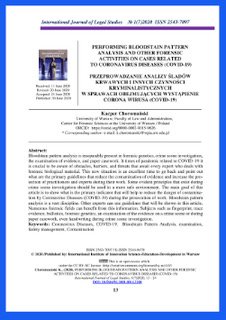By: Kacper Choromański
Bloodstain pattern analysis is inseparably present in forensic genetics, crime scene investigation, the examination of evidence, and paper casework. It times of pandemic related to COVID-19 it is crucial to be aware of obstacles, barriers, and threats that await every expert who deals with forensic biological material. This new situation is an excellent time to go back and point out what are the primary guidelines that reduce the contamination of evidence and increase the protection of practitioners and experts during their work. Some evident principles that exist during crime scene investigation should be used in a more safe environment. The main goal of this article is to show what is the primary indicator that will help to reduce the danger of contamination by Coronavirus Diseases (COVID-19) during the prosecution of work. Bloodstain pattern analysis is a vast discipline. Other experts can use guidelines that will be shown in this article. Numerous forensic fields can benefit from this information. Subjects such as fingerprint, trace evidence, ballistics, forensic genetics, an examination of the evidence on a crime scene or during paper casework, even handwriting during crime scene investigation.
International Journal of Legal Studies No 1(7)2020 ISSN 2543-7097







